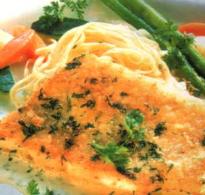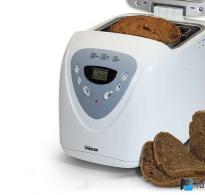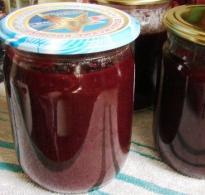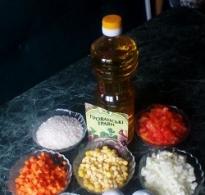Secrets of delicious baking Easter cakes Viennese pastry. Viennese pastry cake
The most coming soon main holiday of all Christians - the Bright Resurrection of Christ. On this day, it is customary to go to church, pray, bless Easter cakes, Easter and eggs, to treat each other and congratulate on this holiday.
Even if you have never baked, it doesn’t matter, we will show you a proven recipe for Viennese dough, from which your pastas will turn out simply amazing.
Sweet Easter from Viennese dough turns out so tasty, airy and fragrant that this recipe will become your favorite.
Easter from Viennese dough does not require much work; such Easter cakes are prepared on a sponge, which must be put on the night.
But in the morning you won’t have to mess around for a long time, the Viennese pastries are baked very quickly.
The dough for Easter cakes turns out to be slightly moist, very tender and soft. Such Easter eggs made from Viennese dough do not get stale for a long time.
Easter recipe from Viennese dough
Ingredients:
- milk - 0.5 l
- flour - 1.5 kg,
- butter - 300 g,
- fresh yeast - 50 g
- eggs - 6 pcs.,
- sugar - 0.5 kg,
- raisins - 150 g,
- vanillin to taste
- salt - 1/2 tsp
How to cook viennese pastry for easter:
All ingredients that you will use to make the Viennese dough should be warm or room temperature so try to get them out of the fridge beforehand.
Butter should be softened, milk should be warm. fresh yeast crumble, pour some milk and stir.
So, we begin to prepare the dough for the Viennese dough.
Choose a larger dish for the dough, as the dough will rise high. You can put the dough in a large enamel saucepan or in a bucket.
Beat eggs with sugar, add yeast and softened butter. Pour in warm milk and stir thoroughly.
Wrap the dough in a warm blanket and leave alone overnight. For 10-12 hours, the dough will rise and fall several times, by morning it will finally ferment.
In the morning, salt, vanillin, flour and raisins should be added to the dough. Raisins should be pre-washed and dried.
Start kneading the dough well until it starts to fall behind your hands. If needed, you can add a little more flour.
Grease the cookie cutters butter and spread the dough, filling up to 1/3 of the volume. Leave to rise in a warm, draft-free place.
When the dough in the forms rises to half, you can put it in an oven preheated to 220ºС.
Easter from Viennese dough will be baked for 40-50 minutes.
While the pastries are baking, prepare the icing or.
To do this, beat 2 proteins and 200 g of sugar until white.
Take the finished Easter eggs out of the oven and coat them directly with hot egg white glaze. Garnish with a variety of sprinkles and pretty Easter decorations.
Here we are with you and prepared amazing and delicious easter from the Viennese test. Enjoy your meal and Christ is Risen!
This cake recipe is suitable for those who do not have a relationship with rich yeast dough. With the recipe for the Viennese dough for Easter cakes, you will forget that the muffin is capricious, requires some special baking skills and is invariably accompanied by an ache in the sides and a spoiled mood. Personally, my Viennese cakes turned out the first time. There were slight doubts when I first put dough without flour. But they dissipated when the next day I kneaded the dough and saw that it was growing literally before my eyes. And what Easter cakes turned out ... Peerless! The recipe for the Viennese dough has been calculated to optimize the production cycle as much as possible. In the evening, the dough is put, then the baker calmly goes to sleep, and the next day he only needs to knead the dough, put it in molds, let it stand for an hour and then into the oven. With this recipe, you will learn a pleasant rule of excellent baking - the less body movements, the better result. I have been using this recipe for more than a year and I can responsibly declare that everything should work out for you the first time. The only thing to remember is that yeast is a living substance. And at temperatures above 40 degrees, the yeast dies. Almost all beginner yeast baking failures are due to yeast overheating. Keep in mind that modern dry yeast, activated with liquid and sugar, will rise even in the refrigerator, but overheating is fatal for them. You don't need to know anything special. Just follow the recipe and you will get exactly the same cakes as you see in the picture.
Ingredients:
- Milk - 1 glass
- Sugar - 1 cup
- Eggs - 2 pcs.
- Flour - 3 cups
- Dry yeast - 16 g
- Butter - 200 g
- Vanilla sugar - 1 pinch
- Raisins - 1/2 cup
For glaze:
- Egg whites - 2 pcs.
- Sugar - 100 g
- Lemon juice - 1/2 tsp

Cooking the Viennese dough for Easter cakes:
It is best to start cooking in the evening, because we will leave the dough overnight.
So, mix in a deep bowl (not aluminum) yeast and warm milk (the temperature is strictly not higher than 38 degrees!). Add a little melted butter and sugar, beat in the eggs. Pour boiling water over the raisins, then dry and add to the dough.

We mix and in this form we leave our mixture at room temperature overnight, covered with a towel.

In the morning the dough increased. Then sift the flour into a bowl and add the vanilla.

We mix everything until a homogeneous consistency.

We take molds for Easter cakes. We prepare them by lubricating with vegetable oil. If the forms are paper, there is no need to lubricate, so immediately fill the molds halfway.

We leave them for a while (30-60 minutes) in a warm place until the dough rises.

We send the approached Easter cakes to bake for 20-30 minutes at a temperature of 180 degrees. You can check the readiness of small Easter cakes after 20 minutes, those that are larger - after 30. We take out finished goods and leave to cool.

In the meantime, let's prepare the glaze. To do this, beat the chilled egg whites to foam formation. Adding a few drops lemon juice and sugar. Beat until firm peaks.
Lubricate the baked products with the prepared glaze and sprinkle with confectionery toppings.

Happy Easter!


Viennese dough for Easter cakes. You can talk about him forever. The recipe for Easter cakes will stay with you forever. It is the aroma of such Easter cakes that you will always associate with bright holiday Easter. If you are looking for your perfect recipe Easter cakes, then try to bake according to this recipe, you will not regret it.
Ingredients:
- 800 grams of flour;
- 70 grams of yeast;
- 5 eggs;
- 250 ml of milk;
- 200 ml cream;
- 150 grams of butter;
- 3-4 tbsp vegetable oil;
- 1.5 cups of sugar;
- 1 glass of raisins;
- Candied fruits can be added if desired;
- A bag of vanilla sugar;
- Salt - 1 tsp;
- Zest of 1 lemon.
Viennese dough for Easter cakes. Step by step recipe
Choux pastry rises more slowly than usual and requires a little more time and effort. But the result is worth all the effort. Easter cakes are the most delicious and do not get stale for a very long time.
Remove all food from the refrigerator in advance so that everything is at room temperature. Crumble the yeast and dissolve in 100 ml of milk, add a teaspoon of sugar and 1-2 tbsp. flour.
Stir and put in a warm place. Sift flour. Knead from 2-3 tablespoons of flour and milk batter like thick sour cream.
Put the container with the dough on the fire and cook until it thickens, stirring constantly and kneading the lumps. Remove from heat, pour in warm cream and stir.
Allow to cool to room temperature. Mix the dough with dough, put in a warm place for 1-2 hours.
Rub the yolks with sugar, salt and vanilla sugar. Add egg yolks, melted butter and vegetable oil. Beat egg whites separately and fold them into the batter.
Now gradually adding flour, knead the dough. Leave to rise in a warm place for 2 hours. When dough rises, add lemon peel, raisins and candied fruits.
Leave for another 30 minutes. Grease the forms with oil, sprinkle with breadcrumbs or flour. Pour batter into molds, filling them ⅓ full.
When the dough in the forms rises a little, send them to the oven, heated to 180 degrees for 45-60 minutes. Avoid opening the oven door for the first 30 minutes.
This Viennese recipe Easter test I like the fact that the dough for him is prepared in the evening, and in the morning the cakes are kneaded and baked. You can make a dough in the morning, and bake Easter cakes in the evening, so it seems to me that this recipe is the easiest. And I also note that Easter cake made from Viennese dough does not get stale for a very long time and only improves over time.
Ingredients:
for the test:
- 1.5 kg flour
- 50 g fresh yeast
- 500 ml milk*
- 300 g margarine or butter*
- 500 g sugar
- 6 eggs
- 1 tsp topless salt
- 300 g raisins
for glaze:
- 2 squirrels
- 100 g sugar
Cooking:
I'm preparing the steam.
Whisk eggs with sugar.
Melt the margarine and add it to the eggs.
Dissolve yeast in slightly warm milk. Add to eggs. Mix well. Cover, wrap in a towel or blanket and leave in a warm place for 8-10 hours. I left it in the kitchen on the table, although it is not so warm there at night, no more than 18 degrees. This is what I had in the morning, the circle turned out at the place where the dough and the towel touched. The dough wanders at night - it rises and falls.

We knead the dough.
In the morning, pour salt into the dough, mix. Gradually add flour and raisins, knead the dough. Soak raisins in warm water for 15 minutes, drain the water and dry.
 Knead the dough until it starts to fall behind your hands. We distribute the dough into molds by ⅓ of the height and leave to rise for about 1 - 2 hours. When the dough will do half the form, put in a preheated to 180 degrees in the oven. We bake Easter until dry matches and ruddy caps.
Knead the dough until it starts to fall behind your hands. We distribute the dough into molds by ⅓ of the height and leave to rise for about 1 - 2 hours. When the dough will do half the form, put in a preheated to 180 degrees in the oven. We bake Easter until dry matches and ruddy caps.


Cooking frosting and decorating cakes
Beat egg whites until stiff, add sugar little by little. Beat until firm peaks. We take the cakes out of the oven, put them on the barrels and let them cool. Decorate with icing and sprinkle with colored powder, candied fruits and other Easter decorations.

The dough according to this recipe is not dry, moist, but at the same time tender, sweet, and such that you eat and want more! So to say in one word viscous-gentle! For those who doubt whether or not to bake Easter according to this recipe, I advise: of course, bake !!!
What are the cooking recipes Easter baking housewives don’t use these days… Here’s another one, absolutely delicious: Viennese pastry for Easter. Such a dough, in general, does not differ from the most ordinary yeast dough. It's just airier, sweeter, and doesn't go stale for a long, long time. Many housewives claim that its taste even improves over time, in any case, Viennese cakes ripen in a day or two. The peculiarity of the preparation of the Viennese dough is that it rises in an average of 10 hours, so it is better to start kneading it in the evening, and finish what you started in the morning. Recipe Viennese Easter cake transmitted from one mistress to another, and at the same time their considerable diversity. We offer you a choice of recipes for Viennese pastry for Easter.
This Viennese Easter recipe is worthy of attention, although it will have to be pretty tricky, and a lot of products will be required. We will need:
- flour - about 3 kg;
- milk - 1 liter;
- live yeast - 100 g;
- granulated sugar - 1 kg;
- eggs - 10-15 pcs.;
- sour cream - 0.5 liters;
- butter - 200 g;
- margarine - 200 g;
- vegetable oil - 0.5 cups;
- salt (adjust to your taste);
- vanillin - a pack.
For dough, it is better to take tall dishes - the dough is already actively rising. An enamel bucket will be just right if you are going to cook a lot of Easter cakes. Products must be at room temperature - this is important.
We start by heating the milk. We pour a glass and dissolve the yeast there. Pour the remaining milk into a bucket, add granulated sugar and salt there. Now we put the eggs, melted butter with margarine and sour cream. Stir all this vigorously, and then add the milk-yeast mixture. We wrap the bucket and put it in any warm place, for example, to the battery. Our dough should ferment for about 6 hours.
Then gradually add flour directly into the bucket and knead the dough. With this first kneading of flour, about 2.5 kg will go away - the dough should turn out soft, elastic and uncooked.
Knead vigorously and thoroughly. When the dough begins to lag behind both the walls of the bucket and the hands, wrap it up - and in warmth. Attention: the dough rises quickly! We crush and wrap again. After the second rise, add vegetable oil, vanillin and raisins (and / or dried fruits).
Knead again without adding flour, and then wrap it up - and warm. After the third rise, the dough is laid out in molds greased with vegetable or butter, filling them to a third of the height. Again, let's stand, rise and "plant" in the oven, heated to 150 degrees.
The baking process lasts from 45 to 60 minutes, it all depends on the size of the molds. Readiness is checked with a wooden toothpick, skewer. Remove from the oven and from the mold, cool, pour fudge or lemon glaze, decorate. Making fudge is extremely simple: grind the protein with a glass of powdered sugar.
If you decide to use the Viennese Easter cake recipe, a special flavor will float in the kitchen for several days.
Other Viennese Dough Recipes
What we need:
- eggs - 12 pcs.;
- granulated sugar - 0.5 kg;
- milk - 0.5 l;
- yeast - 75 g;
- butter - 300 g;
- flour - about 2 kg;
- vanilla - optional;
- raisins and candied fruits;
- salt - to taste, but do not salt the dough, but the dough during kneading.
Mix yeast with warm milk, and eggs - with granulated sugar. Both mixtures are set aside for 12 hours. After this time, both mixtures are combined and introduced soft butter and flour. You can add vanilla if you wish, but this is not necessary - the dough itself is very fragrant. Knead the dough and put it in heat. As soon as it doubles in volume, crush it. The procedure is repeated 3-4 times. At the last punch, add raisins / dried fruits / candied fruits ...
signs ready dough: elastic and not sticky. We lay it out on greased forms, let it stand and bake. It is important to fill the forms by no more than a third: the dough greatly increases in volume both while standing and when it is baked.
Easter recipes are very diverse. Among them is this one:
- flour - 3 kg;
- live yeast - 100 g;
- milk - 1 l;
- margarine or butter - 600 g;
- granulated sugar - 1 kg;
- eggs - 12 pcs.;
- raisins - 200-300 g;
- vanillin - 1 pack;
- salt - 1 tsp without top.
Start by beating eggs granulated sugar. Next, add yeast, soft margarine and milk. Do not put flour! We heat the mixture a little, stirring, until the lumps of margarine disappear. Should be perfect homogeneous mass. We wrap it up and put it in a very warm place for 8-10 hours. All this time, our dough will have to wander and breathe: rise - fall. That is why it is better to knead it in the evening. At night you sleep - the dough breathes.
In the morning (that is, after 8-10 hours), salt the fermented dough, put vanillin, gradually introduce flour and raisins, which I wash and dry ahead of time. The process of kneading the dough lasts until it is easy to lag behind the hands. It is better to add flour, "dusting" on the table, so that the dough does not take too much.
Doesn't stick? Excellent! Now we lay it out on greased molds. You can lubricate with sunflower, but it is still better with creamy: Easter will not stick to the molds. We fill the forms approximately 1/3 of the volume and leave them on the table. Important: the kitchen should be warm, even hot and there should be no drafts. After about 40-50 minutes, the dough will begin to rise. If it fits, then everything was done correctly.
As soon as the dough reaches half of each mold, “plant” the Easter cakes in an oven preheated to 200-250 degrees. You can take it out after 30-50 minutes - the size of the molds matters here.
While Easter is baking, beat the protein with granulated sugar (100 g is enough) and put in the refrigerator. It's sweet. We take out Easter, and while they are hot, grease them with fondant, sprinkle with sugar colored confetti, decorate with chocolate figures and flowers. Our main holiday decoration - Easter cake - is ready!






